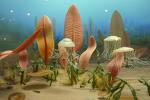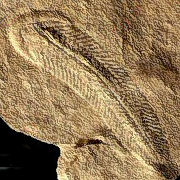 |
 |
 |
 |
 |
Produced
by the Population Genetics and Evolution class, Furman University |
||||
 |
 |
 |
 |
 |
Produced
by the Population Genetics and Evolution class, Furman University |
||||
 |
The
Ediacaran: Spriggina |
 |
Spriggina
is a small worm-like fossil from the Ediacaran period (550 mya), named
after Regg Sprigg who first discovered them in the Ediacara Hills of
southern Australia (Wikipedia 2009). Spriggina was first described
as a segmented worm (Annelid); however, it is currently considered to
be more closely related to the arthropods (Smith 2005). Spriggina
was possibly predatory, and so may be a major factor in initiating the
Cambrian transition and the evolution of animals with hard parts (Wikipedia
2009). Spriggina are curved, un-fused, segmented organisms
approximately three centimeters long. The first of the many segments
form the “head”, which is rounded and contains two indentions
on the upper surface, which were probably eyes (Wikipedia 2009). Two
rows of tough, interlocking plates cover the ventral portion of the
organism; the dorsal portion is only covered by one row (AbsoluteAstronomy
2009). Most specimens contained an antenna and a circular mouth; however,
the types of appendatges it may have had is still unknown (Smith 2005).
Because of its preservation in the lower surface of the fossiliferous
bed, it is believed that Spriggina had a “tough, though
uncalcified, body" (Wikipedia 2009). Page by Matt Medlin |
 |
| Spriggina fossil and animation. | |
| AbsoluteAstronomy.
2009. Spriggina.
Smith, D. 2005. Vendian Animals: Spriggina. University of california Museum of Paleonotology. Wikipedia. 2009. Spriggina. |